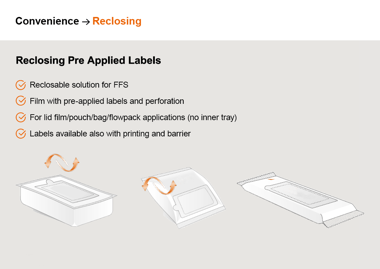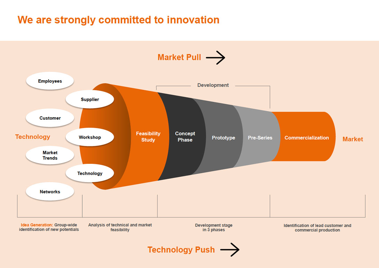A journey full of strategic guideposts
Our customer has a great deal of expertise in packaging solutions that goes far beyond that of its customers. Too often, this can lead to a situation where they do not speak the same language. Convincing communication requires empathy and the ability to change perspectives, which is relevant not only for the presentation, but first and foremost for the innovation process itself.
Our process together began with this change in perspective, which continued as follows:
1
Perspektivwechsel
Wie ticken die Kunden unserer Kunden?

2
Inszenierungswechsel
Wie können wir überzeugender auftreten?

3
Gestaltungswechsel
Wie präsentieren sich Ideen noch ansprechender?

4
Methodenwechsel
Wie können wir das Know-How unserer Mitarbeiter besser nutzen?

First, we introduced user experience approaches such as personas and the customer journey in order to focus on the client’s customer (change in perspective): Who consumes the snack with the packaging involved, when and in what situation? We worked through the following scenarios in particular:
- A snack after lunch
- An energy boost in the car
- An after-sport snack
- Snacking while watching a film
These situations gave rise to concrete ideas on how possible problems could be solved using innovative packaging concepts.
Design Thinking in practice
At the same time, these approaches from the UX world served as a filter to evaluate and prioritise existing ideas and to work out the core concepts - the basis for a convincing presentation.



The crucial question that follows is: How can innovative strength be communicated in such a way that it results in orders?
To achieve this, we implemented storytelling methods (change in staging) and developed the new storyline of the “backbone” for the “snack presentation”. The basic idea behind the new packaging concept was an upright position of the product at the point of sale. The idea of the backbone was well suited to illustrate the importance of an upright posture. A meaningful metaphor combines different aspects of a topic and conveys them in a much more catchy and convincing way than a mere listing of technical advantages.
Finally, a convincing graphic design was needed, the visual part of the packaging: Innovative strength is expressed when the innovative ideas, storyline and presentation interact perfectly (change in design). So we developed a new template system and created illustrations for the presentation that our customer ultimately went with.
Groundwork for a solid presentation
In the graphic implementation, we followed the existing corporate design, but went completely new ways and created a modern look that makes ideas tangible, comprehensible and experienceable, and gets by with little text.
This was the springboard to anchor the innovative potential of the company more deeply in line with its positioning (change in method). We held a Design Thinking workshop in parallel with 75 employees as part of the semi-annual sales conference - an excellent opportunity to better connect key areas of the company and reinforce the topic of innovation.
During the workshop we formed five teams for different innovation areas, and they had two hours to develop new ideas. Live illustrations were created using graphic recording, which also served as inspiration for the design of the presentations.






The aim of the multifaceted cooperation was to find the right factors in the company to bring the brand promise of innovation to life and to give clients the feeling that they are the right partner, and to do this on the basis of a solid foundation anchored in the company.
Flowing inspiration
This process was accompanied by additional internal communication measures such as a regular internal newsletter about innovation, used to communicate the fun in innovation and the desire for more to all employees.

The first concrete result of this process: Our customer was finally able to win over the large food manufacturer with its new presentation and was awarded the contract. A wise saying in sales goes like this: It’s not just about the packaging, it’s the content that counts! Or maybe vice versa, too?










